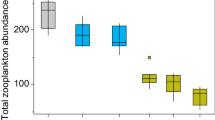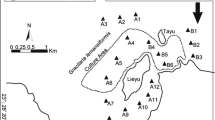Abstract
Harmful algal blooms in the Chesapeake Bay and coastal bays of Maryland, USA, are not a new phenomenon, but may be increasing in frequency and diversity. Outbreaks ofPfiesteria piscicida (Dinophyceae) were observed during 1997 in several Chesapeake Bay tributaries, while in 1998,Pfiesteria-related events were not found but massive blooms ofProrocentrum minimum (Dinophyceae) occurred. In 1999,Aureococcus anophagefferens (Pelagophyceae) developed in the coastal bays in early summer in sufficient densities to cause a brown tide. In 1997, toxicPfiesteria was responsible for fish kills at relatively low cell densities. In 1998 and 1999, the blooms ofP. minimum andA. anophagefferens were not toxic, but reached sufficiently high densities to have ecological consequences. These years differed in the amount and timing of rainfall events and resulting nutrient loading from the largely agricultural watershed. Nutrient loading to the eastern tributaries of Chesapeake Bay has been increasing over the past decade. Much of this nutrient delivery is in organic form. The sites of thePfiesteria outbreaks ranked among those with the highest organic loading of all sites monitored bay-wide. The availability of dissolved organic carbon and phosphorus were also higher at sites experiencingA. anophagefferens blooms than at those without blooms. The ability to supplement photosynthesis with grazing or organic substrates and to use a diversity of organic nutrients may play a role in the development and maintenance of these species. ForP. minimum andA. anophagefferens, urea is used preferentially over nitrate.Pfiesteria is a grazer, but also has the ability to take up nutrients directly. The timing of nutrient delivery may also be of critical importance in determining the success of certain species.
Similar content being viewed by others
Literature Cited
Anderson, D. A., P. M. Glibert, and J. M. Burkholder, In review. Harmful algal blooms and eutrophication: Nutrient sources, composition, and consequences.Estuaries.
Antia, N. J., P. J. Harrison, andL. Oliveira. 1991. The role of dissolved organic nitrogen in phytoplankton nutrition, cell biology and ecology.Phycologia 30:1–89.
Berg, G. M., P. M. Glibert, M. W. Lomas, andM. A. Burford. 1997. Organic nitrogen uptake and growth by the chrysophyteAureococcus anophagefferens during a brown tide event.Marine Biology 129:377–387.
Boynton, W. R., W. M. Kemp, andC. W. Keeee. 1982. A comparative analysis of nutrients and other factors influencing estuarine phytoplankton production, p. 69–90.In V. S. Kennedy (ed.), Estuarine Comparisons. Academic Press, New York.
Bricelj, V. M., andD. J. Lonsdale. 1997.Aureococcus anophagefferens. Causes and ecological consequences of brown tides in the U.S. mid-Atlantic coastal waters.Limnology and Oceanography 42:1023–1038.
Bronik, D. A., M. W. Lomas, P. M. Glibert, K. J. Schukert, andM. P. Sanderson. 2000. Total dissolved nitrogen analysis: Comparisons between persulfate, UV, and high temperature oxidation methods.Marine Chemistry 69:163–178.
Burkholder, J. M., andH. B. Glasgow, Jr. 1997. The ichthyotoxic dinoflagellate,Pfiesteria piscicida: Behavior, impacts, and environmental controls.Limnology and Oceanography 42:1052–1075.
Burkholder, J. M., H. B. Glasgow, Jr., andC. W. Hobbs. 1995. Fish kills linked to a toxic ambush-predator dinoflagellate: Distribution and environmental conditions.Marine Ecology Progress Series 124:43–61.
Dennison, W. C., G. J. Marshall, andC. Wigand. 1989. Effect of “brown tide” shading on eelgrass (Zostera marina L.) distributions, p. 675–692.In E. M. Cosper, V. M. Bricelj, and E. J. Carpenter (eds.), Novel Phytoplankton Blooms: Causes and Impacts of Recurrent Brown Tides and other Unusual Blooms. Lecture notes on coastal and estuarine studies. Springer-Verlag, New York.
Dzurica, S., C. Lee, E. M. Cosper, andE. J. Carpenter. 1989. Role of environmental variables, specifically organic compounds and micronutrients, in the growth of the chrysophyteAureococcus anophagefferens, the “brown tide” microalga. p. 229–252.In E. M. Cosper, V. M. Bricelj, and E. J. Carpenter (eds.), Novel Phytoplankton Blooms: Causes and Impacts of Recurrent Brown Tides and other Unusual Blooms. Lecture notes on coastal and estuarine studies. Springer-Verlag, New York.
Fisher, T. R., L. W. Harding, D. W. Stanley, andL. G. Ward. 1988. Phytoplankton, nutrients, and turbidity in the Chesapeake, Delaware, and Hudson estuaries.Estuarine, Coastal, and Shelf Science 27:61–93.
Fisher, T. R., E. R. Peele, J. W. Ammerman, andL. W. Harding. 1992. Nutrient limitation of phytoplankton in Chesapeake Bay.Marine Ecology Progress Series 82:51–63.
Fudge, H. 1977. The red tides of Malta.Marine Biology 39:381–386.
Glibert, P. M., D. J. Conley, T. R. Fisher, L. W. Harding, Jr., andT. C. Malone. 1995. Dynamics of the 1990 winter/spring bloom in Chesapeake Bay.Marine Ecology Progress Series 122: 27–43.
Glibert, P. M., C. Garside, J. A. Fuhrman, andM. R. Roman. 1991. Time-dependent coupling of inorganic and organic nitrogen uptake and regeneration in the plume of the Chesapeake Bay estuary and its regulation by large heterotrophs.Limnology and Oceanography 36:895–909.
Glibert, P. M. andD. E. Terlizzi. 1999. Co-occurrence of elevated urea levels and dinoflagellate blooms in temperate estuarine aquaculture ponds.Applied and Environmental Microbiology 65:5594–5596.
Gobler, C. J. 1999. A biogeochemical investigation ofAureococus anophagefferens blooms: Interactions with organic nutrients and trace metal. Ph.D. Dissertation. State University of New York, Stony Brook, New York.
Kimor, B., A. G. Moigis, V. Dohms, andC. Stienen. 1985. A case of mass occurrence ofProrocentrum minimum in the Kiel Fjord.Marine Ecology Progress Series 27:209–215.
Kondo, K., Y. Seike, andY. Date. 1990. Red tides in the brackish Lake Nakanoumi (III). The stimulatory effects of organic substances in the interstitial water of bottom sediments and in the excreta fromSkeletonema costatum on the growth ofProrocentrum minimum.Bulletin of Plankton Society of Japan 37:35–47.
LaRoche, J., R. Nuzzi, R. Waters, K. Wyman, P. G. Falkowski, andD. W. R. Wallace. 1997. Brown tide blooms in Long Island’s coastal waters linked to variability in groundwater flow.Global Change Biology 3:397–410.
Lewitus, A. J., J. M. Burkholder, H. B. Glasgow, Jr.P. M. Glibert, B. M. Willis, K. C. Hayes, andM. Burke. 1999b. Mixotrophy and nitrogen uptake byPfiesteria piscicida (Dinophycease).Journal of Phycology 35:1430–1437.
Lewitus, A. J., andD. A. Caron. 1990. Relative effects of nitrogen or phosphorus depletion and light intensity on the pigmentation, chemical composition, and volume ofPyrenomonas salina (Cryptophyceae).Marine Ecology Progress Series 61:171–181.
Lewitus, A. J., D. A. Caron, andK. R. Miller. 1991. Effects of light and glycerol on the organization of the photosynthetic apparatus in the facultative heterotrophPyrenomonas salina (Cryptophyceae).Journal of Phycology 27:578–587.
Lewitus, A. J., H. B. Glasgow, Jr., andJ. M. Burkholder. 1999a. Kleptoplastidy in the toxic dinoflagellate,Pfiesteria piscicida (Dinophyceae).Journal of Phycology 35:303–312.
Lewitus, A. J., R. V. Jesien, T. M. Kana, J. M. Burkholder, H. B. Glasgow, Jr., andE. May. 1995. Discovery of the “phantom” dinoflagellate in Chesapeake Bay.Estuaries 18:373–378.
Lettus, A. J., andT. M. Kana. 1994. Responses of estuarine phytoplankton to exogenous glucose: Stimulation versus inhibition of photosynthesis and respiration.Limnology and Oceanography 39:182–188.
Lomas, M. W., andP. M. Glibert. 1999. Temperature regulation of nitrate uptake: A novel hypothesis about nitrate uptake and cool-water diatoms.Limnology and Oceanography 44:556–572.
Lomas, M. W., P. M. Glibert, G. M. Berg, andM. Burford. 1990. Characterization of nitrogen uptake by natural populations ofAureococcus anophagefferens (Chrysophyceae) as a function of incubation duration, substrate concentration, light, and temperature.Journal of Phycology 32:907–916.
Lomas, M. W., P. M. Glibert, D. A. Clougerty, D. E. Huber, J. Jones, J. Alexander, and E. Haramoto. In press. Elevated organic nutrient ratios associated with brown tide blooms ofAureococcus anophagefferens (Pelagophyceae).Journal of Plankton Research.
Malone, T. C. 1992. Effects of water column processes on dissolved oxygen, nutrients, phytoplankton, and zooplankton, p. 61–112.In D. A. Smith, M. Leffler, and G. Mackiernan (eds.), Oxygen Dynamics in the Chesapeake Bay. Maryland Sea Grant College, College Park, Maryland.
Malone, T. C., L. H. Crocker, S. E. Pike, andB. W. Wendler. 1988. Influences of river flow on the dynamics of phytoplankton production in a partially stratified estuary.Marine Ecology Progress Series 48:235–249.
Malone, T. C., P. G. Falkowski, T. S. Hopkins, G. T. Rowe, andT. E. Whitledge. 1983. Mesoscale response of diatom populations to a wind event in the plume of the Hudson River.Deep-Sea Research 30:149–170.
Maryland Department of Natural Resources. 1998. Water quality, habitat and biological conditions of river systems affected byPfiesteria orPfiesteria-like organisms in the Lower Eastern Shore of Maryland. 1997 Summary. Tidewater Ecosystem Assessment Division. Annapolis, Maryland.
Maryland Department of Natural Resources 1999. Assessment of water quality, habitat and biological conditions related to fish health andPfiesteria-like organisms in Maryland. Summary 1998. Tidewater Ecosystem Assessment Division. Annapolis, Maryland.
McCarthy, J. J., andJ. L. Nevins. 1986. Utilization of nitrogen and phosphorus by primary producers in warm-core ring 82-B following deep convective mixing.Deep-Sea Research 33: 1773–1788.
Parsons, T. R., Y. Maita, andC. M. Lalli. 1984. A Manual of Chemical and Biological Methods for Seawater Analysis. Pergamon Press. Elmsford, New York.
Richardson, K. 1997. Harmful or exceptional phytoplankton blooms in the marine ecosystem, p. 302–386.In J. H. S. Blaxter and A. J. Southward (eds.), Advances in Marine Biology, Vol. 31. Academic Press, San Diego, California.
Seliger, H. H., J. A. Boggs, andW. H. Biggley. 1985. Catastrophic anoxia in the Chesapeake Bay in 1984.Science 228: 70–73.
Shimizu, Y., N. Watanabe, andG. Wrensford. 1993. Biosynthesis of brevetoxins and heterotrophic metabolism inGymnodinium breve, p. 351–357.In P. Lassus, G. Arzul, E. Erard-Le-Denn, P. Gentien, and C. Marcaillou (eds.), Harmful Marine Algal Blooms. Lavoisier Publishing, Paris.
Skovgaard, A. 1998. Role of chloroplast retention in a marine dinoflagellate.Aquatic Microbial Ecology 15:293–301.
Smayda, T. J. 1989. Primary production and the global epidemic of phytoplankton blooms in the sea: A linkage?, p. 449–483.In E. M. Cosper, V. M. Bricelj, and E. J. Carpenter (eds.), Novel Phytoplankton Blooms: Causes and Impacts of Recurrent Brown Tides and other Unusual Blooms. Lecture Notes on Coastal and Estuarine Studies. Springer-Verlag, New York.
Smayda, T. J. 1997. Harmful algal blooms: Their ecophysiology and general relevance to phytoplankton blooms in the sea.Limnology and Oceanography 42:1137–1153.
Stoecker, D. K. 1998. Conceptual models of mixotrophy in planktonic protests and some ecological and evolutionary implications.European Journal of Protistology 34:281–290.
Stoecker, D. K., A. Li, W. Coasts, D. E. Gustafson, andM. K. Nannen. 1997. Mixotrophy in the dinoflagellatePromocentrum minimum.Marine Ecology Progress Series 152:1–12.
Syrett, R. J., K. J. Flynn, C. J. Molloy, G. K. Dixon, A. M. Peplinska, andR. C. Creswell. 1986. Effects of nitrogen deprivation on rates of uptake of nitrogenous compounds by the diatom,Phaeodactylum tricornutum Bohlin.New Phytologist 102: 39–44.
Wikfors, G. H. andR. M. Smolowitz. 1995. Experimental and histological studies of four life-history stages of the eastern oyster,Crassostrea virginica, exposed to a cultured strain of the dinoflagellateProrocentrum minimum.Biological Bulletin 188: 313–328.
Sources of Unpublished Materials
Simpson, T. Personal Communication. State of Maryland, Department of Agriculture, The Wayne A. Crawley Jr. Building, 50 Harry S. Truman Parkway, Annapolis, Maryland 21401.
Stoecker, D. Unpublished Data. Horn Point Laboratory, University of Maryland Center for Environmental Science, P.O. Box 775, Cambridge, Maryland 21613.
Author information
Authors and Affiliations
Corresponding author
Rights and permissions
About this article
Cite this article
Glibert, P.M., Magnien, R., Lomas, M.W. et al. Harmful algal blooms in the Chesapeake and Coastal Bays of Maryland, USA: Comparison of 1997, 1998, and 1999 events. Estuaries 24, 875–883 (2001). https://doi.org/10.2307/1353178
Received:
Accepted:
Issue Date:
DOI: https://doi.org/10.2307/1353178




